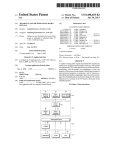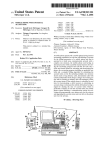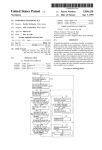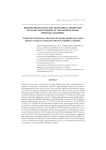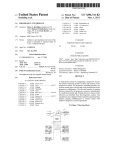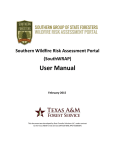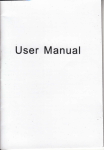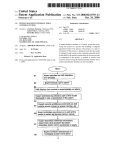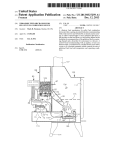Download IIIIIIIIIIIIIIIliIIIIIIIil11:
Transcript
US008121614B2 (12) United States Patent (16) Patent N6; Lee (54) US 8,121,614 B2 (45) Date of Patent: APPARATUS AND METHOD USING RADIO (56) Feb. 21, 2012 References Cited SIGNALS U.S. PATENT DOCUMENTS (75) Inventor: (73) Assignee: Samsung Electronics Co., Ltd (KR) (*) Jung-Hwan Lee, Middlesex (GB) , , Not1ce: , 6,731,940 B1 * 5/2004 Nagendran .............. .. 455/4561 2005/0182847 A1* 8/2005 JaWad PirZada et a1. 709/233 2005/0260989 A1 * 11/2005 Poul?er et a1~ ~~~~~~~~~~ ~~ 455/4353 , , Subject to any d1scla1mer, the term of th1s patent is extended or adjusted under 35 U-S-C- 154(1)) by 256 days- 2008/0049675 A1* 2/2008 2008/0293367 A1* 11/2008 Burgan et a1. W lff tal. ...... . . . . . .. 370/331 ................ .. 455/903 u e FOREIGN PATENT DOCUMENTS 1 670 265 6/2006 EP * cited b examiner (21) Appl. No.: 12/397,701 y ' Primary Examiner * Aj it Patel (22) Flledi Mal? 4: 2009 (65) Prior Publication Data US 2009/0227 27 1 A1 Sep_ 103 2009 (30) (74) Attorney, Agent, or Firm * The Farrell LaW Firm, PC. (57) ABSTRACT A method of using radio signals transmitted for reception by mobile user equipment that includes receiving, With mobile Foreign Application Priority Data user equipment (UE), radio signals having at least one format; momtormg, W1th the mob1le user equlpment, at least one Mar. 4, 2008 (GB) ................................. .. 08040131 PYPPPYYY Qfthe received radio Signals} identifying a Panem in sa1d momtored property or propertles; and 1n response to (51) Int Cl identifying said pattern, triggering at least one action accord H0211”)/0 0 (2006 01) U 5 Cl (58) Field of Classi?cation Search ...................... .. None . . ' ing to the identi?ed pattem, and/or providing the UE With an (52) . 455/456 1 455/522 ................................... .. . indication of a location of the UE based at least part of the ; identi?ed pattern‘ See application ?le for complete search history. 16 Claims, 3 Drawing Sheets : 41 43 45 l 1 2 2 2 l } i Data Log Tracking Alarm Application r l Pro?le Control I?» 40 Power Control : J a FII:IIIIIIIIIIIIIIIIIZIIZIZiIIIIIIIfi r Service l l L Handler “'35 l l l l l 33 31 1 l l : Pattern 08 'r‘v 30 l t | Pattern Matching l l L _______________________________ __J r --------------- -+ -------------- “1 r1 r Measurement Report : l I | 23 3 l t 21 | ‘~20 l l l L3 (PRO) 2 I i :IIIIIIIIIIIIIIIliIIIIIIIil11:: } 11 i3 15 l i : l GSM/UMTS t WLAN 2 GPS r 1'“ ‘O l l l l US. Patent Feb. 21, 2012 Sheet 1 013 Alarm Application Measurement Report GSM/UMTS WLAN FIG.1 Profile Control Power Control US 8,121,614 B2 US. Patent Feb. 21, 2012 Sheet 2 013 US 8,121,614 B2 ( Start ) Service Request ~100 i Scan Pattern DB is the ~ 105 no 230 Pattern DB has relevant Activate Training Mode & _>@ history data? Reiect the request Training Mode Set-Up Triggering Criteria & __ 1 15 Timer i , Activate Measurement Devices it not 120 . . + Monitor Measurement Reports 140 "" 125 2 Adjust the frequency of monitoring oes the measurementrepor match to theTnggermg Criteria? Report to the Service Handler ~ 150 Update the Pattern DB Reiect the request |~i55 1 End FIG.2 ~ 145 US. Patent Feb. 21, 2012 Sheet 3 013 US 8,121,614 B2 Select the criteria to evaluate i“ 205 215 2 Setreassessment up the timer for High Credibility? @ Access the server and Download the information ~ 225 & update the DB High Credibility? Produce questionnaire to the user & set timer w235 ls timer expired? Collect measurement Yes Log the measurement re ort until the time 0 configured ~ 265 Request the decision to the user & get l ~ 270 ¢(________— Set up the timer for reassessment @ ‘' 245 L255 l_—_ Process Auto-training & make decisions report '” 275 FIGB US 8,121,614 B2 1 2 APPARATUS AND METHOD USING RADIO SIGNALS provide methods and apparatus Which overcome, at least partially, one or more of the problems or disadvantages asso ciated With the prior art. PRIORITY SUMMARY OF THE INVENTION This application claims priority under 35 U.S.C. §1 19(a) to an application entitled “Apparatus and Method Using Radio Signals” ?led in the United Kingdom Intellectual Property According to a ?rst aspect of the present invention there is provided a method of using radio signals transmitted for reception by mobile user equipment, the method includes receiving, With mobile user equipment, radio signals having O?ice on Mar. 4, 2008 and assigned Serial No. 0804013. 1, the contents of Which are hereby incorporated by reference. at least one format; monitoring, With the mobile user equip ment, at least one property of the received radio signals; identifying a pattern in said monitored property or properties; BACKGROUND OF THE INVENTION and in response to identifying saidpattem, performing at least 1. Field of the Invention The present invention relates to a method of using radio one of triggering at least one action according to the identi?ed pattern; and providing With the UE an indication of a location of the UE based at least in part on the identi?ed pattern. signals transmitted for reception by mobile user equipment and to systems and apparatus implementing or using such a method. 2. Background to the Invention A Wide variety of electronic mobile user equipment is knoWn for receiving radio signals for a Wide variety of pur Thus, in this method radio signals intended for reception are used by mobile user equipment in neW Ways, i.e. for 20 additional purposes. For example, the radio signals being received by the user equipment may be telecommunications signals in GSM, UMTS, UTRAN, or Evolved-UTRAN poses. Such mobile User Equipment (UE) includes mobile (E-UTRAN) systems and Will typically include information phones (Which may also be referred to as cell phones or relating to audio or data content. The user equipment Will handsets), Personal Digital Assistants (PDAs), Global Navi gation Satellite System (GNSS) receivers, and other equip 25 ment. It Will be appreciated that in addition to being able to receive one or more formats of transmitted radio signals, certain examples of knoWn UEs are also able to transmit radio signals. This is of course the case With mobile phones for use in a telecommunication system. Similarly, devices such as PDAs are able to transmit radio signals in order to exchange data With other equipment. Also, in addition to dedicated GNSS receivers, GNSS receiver functionality can also be incorporated in mobile user equipment having other func 30 pattern (i.e. change) and trigger some action in accordance off or poWer doWn its GPS receiver When it sees a sharp drop 35 for user equipment to be able to receive and process radio 40 is knoWn for a mobile handset to be able to receive and send mobile telephone signals in Global System for Mobile com munications (GSM) and/or Universal Mobile Telecommuni cations System (UMTS) or UMTS Terrestrial Radio Access Network (UTRAN) systems, in addition to being able to send and receive Wireless Local Area Network (WLAN) signals Will be triggered at the set time, irrespective of Where the user equipment is located or What the user of the equipment is doing or has been doing). In the case of user equipment With the ability to determine its location from GNSS signals, a knoWn problem is that in certain locations the availability of such signals is restricted (and indeed no such signals may be available) and then the device is unable to continue determining its location. in GSM phone signal strength indicative of entry into a build ing. In certain embodiments the user equipment is adapted to receive a plurality of radio signals in plurality of formats. Generally, the method is able to monitor parameters of those received signals and from those observed patterns derive information (such as location information). In certain embodiments the received radio signals include radio signals transmitted from at least one transmitter located at a terrestrial location. In certain embodiments these radio 45 for shorter range communication. Such user equipment can also provide an alarm function. HoWever, this alarm function is typically arranged such that the alarm is triggered according to time only (that is, the alarm strength may correspond to the user equipment being taken inside a building. The method may be arranged to identify this With the change. For example, the UE may be arranged to turn tions, for example a mobile phone having the capability to determine its location using GNSS signals. It is also knoWn signals of different formats from a corresponding plurality of transmitters arranged at terrestrial locations. For example, it typically be adapted to process these received signals in the usual Way for the normal purposes, but additionally may monitor and respond to observed patterns in some property of the received signals, such as the received signal strength. For example, a sudden or abrupt reduction in received signal 50 signals include radio signals transmitted from a plurality of terrestrial transmitters in plurality of signal formats. Additionally, the received radio signals may include sig nals transmitted from at least one Space Vehicle (SV). Thus, in examples Where the user equipment is adapted to receive GPS signals, the UE can process the received signals in the usual Way to determine its location, but additionally, by moni toring properties of the GPS signals (for example received signal strength) and identifying patterns in those measured properties, the UE or some other apparatus interacting With 55 the UE can derive further information for use in location determination or for other purposes. In certain embodiments the pattern includes at least one of a temporal pattern, a chronological pattern, a static pattern, an instantaneous pattern, and a dynamic pattern. Thus, the pat tern can include combinations of measured properties of a 60 It is also knoWn for users to be able to manually change or plurality of different received radio signals at a particular time update the pro?le or con?guration of their mobile user equip or location and/or may include patterns of changes in mea sured properties over time. For example, a particular combi ment. nation of received signal strengths may form part of a pattern Certain embodiments of the present invention aim to pro vide improved methods of using radio signals transmitted for reception by mobile user equipment, and improved apparatus and improved user equipment. Certain embodiments aim to Which indicates a user of the user equipment is at, or close to, 65 home. The pattern may also include an abrupt change in signal strength of one type of received signal. When that combination of signal strengths is observed together With an US 8,121,614 B2 4 3 abrupt drop in signal strength of another signal, such as a GPS In certain embodiments the at least one action triggered signal, this can be used as an indication that the user is not just at or close to home but has actually entered their house. (i.e. carried out) in response to identifying a particular pattern includes providing (from the mobile user equipment) a signal Similarly, When the combination of received signal strengths for a user of the equipment, changing a con?guration of the user equipment or external apparatus, sWitching the user is observed together With a sudden increase in strength to the equipment betWeen one operational mode and another, and/or sWitching an apparatus external to the user equipment betWeen one operational mode and another. Other actions may of course be performed in alternative methods embody GPS signal this can be used as an indication that the user has just stepped out of their house. Clearly, there are a Wide variety of Ways in Which the embodiments of the invention can monitor patterns in properties of received signals and use those patterns as indications of location and/or movement. ing the invention. Thus, in certain embodiments the pattern being identi?ed An example of a signal Which the mobile user equipment includes a change in at least one monitored property of at least one received radio signal. may provide to a user is an alarm signal. Others include a Additionally, the pattern may include an instantaneous combination of monitored properties of a plurality of differ ent received radio signals (i.e. in different formats, such as visual signal. Thus it Will be appreciated that certain embodi ments of the invention may identify (recognize) a particular GSM, GPS, WLAN, etc). user equipment as a person carries that equipment around, and according to that observed pattern can provide a useful reminder signal, a location signal, an audible signal and a pattern involving parameters of radio signals received by the In certain embodiments the at least one property can include a BLock Error Rate (BLER), a Bit Error Rate (BER), a Received Signal Strength Indicator (RSSI), a Common signal such as an alarm or a reminder. In contrast to alarm 20 PIlot CHannel Received Signal Code PoWer (CPICH RSCP), and/ or an SV poWer. In certain embodiments the method further includes moni toring, using the mobile user equipment, information con tained in the received radio signals. This information may be used in conjunction With the information derived from 25 arranged to spot When a user leaves home With the user In embodiments in Which the user equipment is used to 30 the pattern being identi?ed (i.e. being looked for) may also eters) and issue a reminder signal, for example, to the user regarding something he or she should do on the Way to Work. Thus, the reminder can be issued at a truly appropriate time, rather than simply at a notional set time at Which the user expects to be leaving for Work. include one or more patterns in the contained information, together With one or more patterns in the monitored signal parameters. For example, the user equipment may be arranged to receive mobile telephone signals and at certain mentioned above, embodiments of the invention may be equipment (by appropriate monitoring of radio signal param observing patterns in monitored parameters to provide improved location determination and/or other functionality. monitor information contained in the received radio signals, signals or reminders provided by prior art systems, Which in general could only issue a reminder or alarm at a particular set time, irrespective of Where the user Was, embodiments of the invention are thus able to use the observed patterns to provide a more sophisticated alarm or reminder functionality. As An example of sWitching the user equipment betWeen one operational mode and another is Where the user equipment 35 locations Will be able to receive those radio signals from a comprises a GPS or other GNSS receiver and in one opera tional mode this receiver is operated at a ?rst level of poWer corresponding plurality of base stations. The signal from each consumption, and in the other operational mode it is operated base station may include information indicative of the iden tity of that base station. Thus, the user equipment may, in at a reduced poWer level (or even sWitched off entirely). Thus, in certain embodiments of the invention ob served patterns in signal properties could be used to save poWer by at least partially sWitching off a GPS receiver When the observed patterns are indicative of the user being in a location Where location determination from GNSS signals Will not be pos sible. An example of sWitching an external apparatus from one operational mode to another is Where an observed pattern is addition to being able to monitor received signal strengths, look at the information contained in the received signals and 40 identify from Which combination of base stations the user equipment is receiving signals from at that location. A par ticular combination of base stations may correspond to a particular location, such as the user’s home or Workplace. Thus, the method can derive some location information from the information contained in the received radio signals. Addi tionally, the user equipment may look for a pattern of change in a measured parameter (such as a rapid or abrupt change in the received strength of a GPS signal) Which, together With the combination of base stations at a particular location, is 45 used to sWitch on an apparatus only When it indicates that a user has entered a particular environment, such as sWitching on a television or other display unit or sWitching on lights 50 When a user arrives at his or her of?ce or home. Another able to indicate Whether the user is arriving at or leaving home example Would be Where user equipment in the form of a mobile phone is arranged to hand over its display function to or Work. a television When a user arrives at Work or home. In certain embodiments, the information includes a neigh boring cell IDenti?er (ID) list, a base station identity code, a Subscriber Trunk Dialing (STD) code or region or area code, 55 that includes mobile User Equipment (UE) arranged to a service set identi?er, a time and/or a date, a GPS day of Week, and/or a multipath indication. In certain embodiments the identifying step includes pro cessing the results of the monitoring into a particular data format, and then comparing the results in that format With data stored in a memory. Additionally, the method may fur According to a second aspect of the invention there is provided apparatus (Which may also be described as a system) 60 receive radio signals having at least one format and includes monitoring means arranged to monitor at least one property of the received radio signals; pattern identi?cation means arranged to identify a pattern in said monitored property or properties; and response means arranged to perform, in monitoring signal parameters (and the information they con response to the pattern identi?cation means identifying said pattern, triggering at least one action according to the identi ?ed pattern; and/ or providing the UE an indication of a loca tion of the UE based at least in part on the identi?ed pattern. In certain embodiments the UE is arranged to receive radio tain). signals transmitted from at least one transmitter located at a ther include using the results (processed into the particular format) to update the stored data. Thus, the system may be able to identify and “learn from” patterns observed from 65 US 8,121,614 B2 5 6 terrestrial location. Additionally, the UE may be arranged to receive radio signals transmitted from at least one Space arranged reception means in the home to turn on lights, turn on heating, sWitch certain apparatus into standby mode etc. In certain embodiments the UE includes the pattern iden ti?cation means, although in alternative embodiments the pattern identi?cation means may be provided elseWhere in the Vehicle (SV). In certain embodiments, the pattern being identi?ed or recogniZed includes a temporal pattern, a chronological pat tern, a static pattern, an instantaneous pattern, and/ or a system (i.e. external to the UE). Similarly, the UE may dynamic pattern. property of at least one received radio signal. Additionally, include the response means, although in alternative embodi ments the response means may be external (for example a communication netWork adapted to communicate With the UE may perform the action or actions in response to detec the pattern may include an instantaneous combination of tion/recognition/identi?cation of a particular pattern in For example, in certain embodiments a pattern Which may be recognized includes a change in at least one monitored received signal properties. monitored properties of a plurality of different received radio Another aspect of the invention provides mobile user signals. equipment (UE) including signal reception means arranged to In certain embodiments the at least one property includes a receive radio signals having at least one format; monitoring received signal strength or poWer of a received radio signal. means arranged to monitor at least one property of the In certain embodiments the at least one property includes a BLock Error Rate (BLER), a Bit Error Rate (BER), a Received Signal Strength Indicator (RSSI), a Common PIlot CHannel Received Signal Code PoWer (CPICH RSCP), and/ 20 or an SV poWer. In certain embodiments the UE is further arranged to moni tor information contained in the received radio signals. Then, the pattern identi?cation means may be adapted to identify a pattern or patterns including a pattern in said information. The information may, for example, include a neighboring cell ID list, a Base Station Identity Code (BSIC), a Subscriber 25 received radio signals; and pattern identi?cation means arranged to identify a pattern in said monitored property or properties, Wherein the UE is arranged to respond to the pattern identi?cation means identifying said pattern by per forming triggering at least one action according to the iden ti?ed pattern, and/or providing an indication of a location of the UE based at least in part on the identi?ed pattern. It Will be appreciated that optional features of the other aspects of the invention described above may also be incor porated in UEs in accordance With this third aspect, With corresponding advantage. Accordingly, a description of those Trunk Dialing (STD) code or region (i.e. area) code, a Service features Will not be repeated here. Set IDenti?er (SSID), a time and/or a date, a GPS day of Week, and/or a multipath indication. In certain embodiments, the apparatus or system further includes processing means arranged to process data from the monitoring means (that data being indicative of the at least one property of the received radio signals) into a predeter mined data format. In certain embodiments the UE includes this processing means, although in alternative embodiments the processing means may be provided external to the UE, With the UE being adapted to transmit monitoring data to the processing means for processing. 30 In certain embodiments the pattern identi?cation means is 40 Embodiments of the invention Will noW be described With reference to the accompanying draWings, of Which: FIG. 1 is a block diagram illustrating an embodiment of the 35 FIG. 2 is How chart illustrating an embodiment of the FIG. 3 is a How chart illustrating an embodiment of the present invention. DETAILED DESCRIPTION OF EMBODIMENTS OF THE INVENTION mined format With data stored in a memory or database. This 45 50 could be used to modify/update the stored data. The database 55 UMTS or GSM radio interface in a mobile phone. Certain embodiments provide the advantage that they are 60 able to provide cost-effective location information so that a user can use this for precise reminder/ alarming, position tracking and pro?le or con?guration changes. This is in con trast to prior art reminder/ alarm systems in Which triggering signal from suitable transmission means) for reception by other apparatus. This other apparatus may form part of the ing or entering home, the UE may transmit a signal to suitably tion may be described as location edge and Zone detection methods based on radio signals and user behavior. An area to Which certain embodiments of the invention applies is the examples, include the UE transmitting a signal (eg a radio apparatus/ system as a Whole. For example, in response to the UE detecting a signal pattern indicative of the user approach hensive understanding of exemplary embodiments of the invention. Accordingly, those of ordinary skill in the art Will recogniZe that various changes and modi?cations of the embodiment described herein can be made Without departing from the scope and spirit of the invention. It Will be appreciated from the above description and from the description beloW that certain embodiments of the inven can thus evolve. The action triggered/performed in response to the identi? cation of a pattern in the observed signal property or proper ties may, for example, include providing from the mobile user equipment a signal for a user of the equipment; changing a con?guration of the user equipment or external apparatus; sWitching the user equipment betWeen one operational mode and another; and/or sWitching apparatus external to the user equipment betWeen one operational mode and another. It Will be appreciated that the triggering of an action may, in certain Preferred embodiments of the present invention Will noW be described in detail With reference to the annexed draWings. The matters de?ned in the description such as a detailed construction and elements are provided to assist in a compre updating means arranged to update the stored data using the data processed into the predetermined format. In other Words, the processed data relating to observed signal properties present invention; present invention; and arranged to compare the data processed into said predeter database may be provided in the UE, or alternatively may be provided at a different location. For example, the database may be provided in a communication system or netWork arranged to communicate With the UE. In certain embodiments the apparatus further includes data BRIEF DESCRIPTION OF THE DRAWINGS 65 of an event reminder Was based on time-line information only. Certain embodiments may also be used for asset or user tracking applications, and provide advantages over prior art systems limited to use either outdoors, or requiring extra US 8,121,614 B2 7 8 equipment and components, such as Radio Frequency IDen ti?cation (RFID) tags for indoor use. UEs camped on the base station (BS), and the certainty of triggering can be improved When the triggering is linked With Certain embodiments are also able to provide the advan (i.e. used in conjunction With) time information, and Cell-ID tage of automated pro?le and/or con?guration changes in and STD code. response to detected signal patterns, in contrast to prior art systems asking users to change the pro?le or con?guration directly and manually. Certain embodiments, by identifying patterns involving the combination of time information and location signal pat terns, are able to increase the accuracy and reliability of 10 position estimation. Embodiments may be implemented Without requiring Various properties of radio signals may be monitored in embodiments of the invention, and a variety of information may be extracted from those radio signals. Examples of such properties and information, Which are monitored and used in embodiments of the invention, are shoWn in the folloWing table. Table 1 indicates the technology (air interface and sub interface) to Which each property or information that can be monitored relates. extra hardWare for indoor use, and so implementation may be TABLE 1 Air Interface Sub Interface Cellular GSM Information of Interest Reference BLER (Block Error Rate), BER (Bit Error 3GPP Rate), RSSI (Received Signal Strength Indicator) Neighbor Cell ID List, BSIC (Base Station Identity Code), STD Code/Region Code in CB (Cell Broadcast) CPICH RSCP (Common Pilot Channel, UMTS CPICH Eb/NO 25.331 (RRC), 25.215 (PHY Measurements) WLAN GPS WLAN GPS SSID, RSSI SV Power in dBm, Satellites Visible, Time AGPS & Date (GWT) GPS TOW (Time of Week), Multipath IEEE 802.11 3GPP Indicator 30 cost-effective and realiZed in a typical mobile phone. The UE For mobile UE adapted for use in GSM/UMTS systems, occasionally a mobile is requested by the cellular netWork to may include one or more radio signal interfaces such as WLAN, GPS or GSM/UMTS, and in certain embodiments the method or system utiliZes the best available information (e. g. canuse all of the available signals/ signals received) from measurements to provide reliable location edge or Zone infor mation. It Will be appreciated that information may be derived from measurements on radio signals received by a mobile UE. A monitor neighboring BS signals, especially broadcasting 35 Depending on the location and the tra?ic of the BS, obser vations of received signal properties can shoW certain patterns 40 position of the mobile UE and/or a behavior of a user can be received signal patterns along With previous parameter his tory. For example, by monitoring properties of received radio 45 50 (UE) tries to acquire satellite signals and the UE returns (i.e. measures/monitors) received signal poWer in dBm and the number of satellites currently visible (With the corresponding satellite identity number). Additionally, if Assisted GPS (AGPS) service is provided by the cellular netWork, the For example, in an urban home environment, Whether the UE is in a living room or at the door, the list of IDs of surrounding BSs and the area codes from each are usually the same (one may lose some Weak BS signals from time to time). HoWever, the RSSI and the multipath propagation values are monitor neighboring APs, monitoring the SSID contained in, and the signal strength of the received signal from each. In certain embodiments, the UE is operable in at least one GNSS system, e. g. GPS. To calculate its position, the mobile certain place that he/ she visited before (i.e. if the UE is at or in a “Zone”); and/or if the mobile is entering or moving out of the Zone. Which can be used to make a determination about the location of the UE. In certain embodiments, the UE is operable in a WLAN. To camp on an Access Point (AP), the mobile should typically determined (at least to some degree) by analyZing the signals one can determine: If the mobile device is indoors or outdoors; if the mobile device is at a user’s home, o?ice or a channels or pilots. By monitoring this type of signal the UE can typically determine: the ID (identity) of each BS, Which is Cell-ID or BSIC; Signal Strength, typically RSSI; and/or Optional: STD (Subscriber Trunk Dialing) Area Code. mobile can get extra information such as a multipath indica tor. 55 A system according to an embodiment of the present inven tion Will noW be provided, With reference to FIG. 1. The core substantially changed When the mobile equipment (UE) system has 2 parts: a measurement part (20) and decision moves from indoors to outdoors. In that case, the UE itself (or some other component of a system incorporating the UE) can making part (30). Modems (10), Which may include Radio Frequency (RF) modem, of various radio receivers provide record the observed (i.e. measured) pattern of signals and their changes. Then, Whenever this pattern is observed, the 60 useful measurement in a prede?ned report format. For example, the modems (10) may include a GSM/UMTS signal processing module (11) for transmitting and receiving radio UE can report to an alarm or reminder system to be linked signals based on a GSM or UMTS protocol, a WLAN signal With time-driven event trigger system. It Will be appreciated that the pattern of radio frequency (RF) signals received by a UE is in?uenced, in the sense that it varies, by various factors including moving cars and other processing module (13) for transmitting and receiving radio 65 signals based on a WLAN protocol, and a GPS signal pro cessing module (15) for transmitting and receiving GPS sig nals. US 8,121,614 B2 10 The measurement part (20) includes a measurement report unit (21) Which extracts information to be used by an appli other hand, if the timer has not expired in step 125, the frequency of monitoring is adjusted in step 140 and opera cation processor (40) from signals provided from the modems (10) and provides the extracted information to the decision making part (30). For example, the measurement part (20) tions are repeated from step 125. If the measurement report satis?es the triggering criteria in step 130, the pattern match ing unit (31) reports this fact to the service handler (35) in step 150 and updates information of the pattern DB (33) in step may extract related information disclosed in Table 1 and provide the extracted information to the decision-making part 155. (30). In the service request step, step 110, at least one criterion among location and time should be sent to the service handler The decision-making part (30) includes a pattern matching unit (31), a pattern database (DB) (33), and a service handler (35) to arrange the service. Examples are provided in Table 2. (35). The pattern matching unit (31), by comparing the pre vious patterns stored in the pattern database (DB) (33), can TABLE 2 make a decision or generate triggering events provided to the service handler (35). The role of the service handler (35) is to interface various application processors (40) or customers capturing What triggering event they Want, and generating the 20 example, the application processor (40) may include proces a Radio Resource Controller (RRC) (23) are more desirable. This information should be produced for the cellular netWork anyWay, and thus does not require any extra function or pro cessing in the mobile device. Operation of the system embodying the invention Will noW be described in more detail. A summary of operation is pro vided in the How chart of FIG. 2. Further information regard ing the function of the service handler (35), sub How of training mode or triggering criteria, are to be found beloW. 25 30 35 40 45 When the criteria are satis?ed. Such criteria are exchanged 50 100, a user de?nes triggering criteria and the action to be 55 Date Band Time Band Weekdays, Weekends, or User-De?ned Hour:Min:Sec(start)-Hour:Min:Sec(end) Credibility High, Mid(default), LoW After the service execution, the service handler (35) can ask the user or the application processor (40) about the cred ibility. When the user or the application is not satis?ed With the result, the system can ask the user for manual training or the present invention, may be performed based on a mecha nism described beloW. There are 3 sub-modes in the training: server doWnload, user manual training and automatic training. These modes are illustrated in FIG. 3. The server can produce typical informa tion or speci?c information. User manual training mode col lects the user’s preferences and Whenever a likely criteria happens, the system requests con?rmation from the user if this instant criteria is What the user Wants for a triggering event. The automatic training mode is Where the preferences are pre-con?gured by the system and the system requests a con?rmation based on likely criteria. HoWever, because of the built-in reassessment timer, the system occasionally re-evalu ates all of the credibility of the information parsed and stored and arranges training or updating. according to an embodiment of the present invention includes server doWnload in steps 205-225, user manual training in speci?cally, the server may generate a general information ?le or detailed information. Thus, the system selects criteria for evaluation in step 205, and determines if the selected criteria have high credibility in step 210. If the criteria have a high credibility, the timer for reassement is set in step 215. On In step 220, the system determines if it can access the server, and if the system can access the server, the system accesses the server to doWnload information and update the pattern DB (33) in step 225. the stored data enables the request to be met, the triggering If the system cannot access the server, the system deter criteria and a timer are set (step 115). Next, the system activates the measurement part (20) in Yes/No the other hand, if the criteria do not have high credibility, the system proceeds to step 220. performed When those triggering criteria are met. The system then scans the pattern database (33) to determine if it stores any data relevant to the speci?ed criteria in a step 105, ie step 120. The pattern matching unit (31) monitors a measure ment report from the measurement part (20) in step 125, and determines if the measurement report satis?es triggering cri teria in step 130. If the measurement report does not satisfy the triggering criteria, it is determined in step 135 if the set timer has expired. If the timer has expired, the service request is rejected in step 145 and the operation is terminated. On the Zone Edge steps 230-255, and automatic training in steps 260-275. More handler (35) delivers the requested trigger to the application does the pattern DB (33) contain data enabling the triggering request to be implemented. If the pattern DB (33) does not, the system proceeds to activate a training mode (step 200). If Home, Of?ce, Car Park, Supermarket, Indoor, For example, referring to FIG. 3, the training step, step 200, The application sends a request for the service to the ser betWeen the application processor (40) and the service han dler (35). In other Words, in the “Service Request” step, step Zone The training step, step 200, according to an embodiment of service handler (35). vice handler (35) and the service handler (35) determines if it is capable of handling the request. If capable, the service Location adjust its pattern DB (33). FIG. 2 is a ?owchart illustrating an operation process of a system according to an embodiment of the present invention. Referring to FIG. 2, the system according to an embodiment of the present invention is initiated by an operation of the Parameters Time & Date event generated by the decision-making part (3 0). For sors 41, 43, and 45 Which process an application for tracking data log information, an alarm application, an application for executing pro?le or poWer control, etc. To minimiZe the engineering Work, in UMTS/GSM, rather than extracting the measurement report from the physical layer Layer 1 , measurement reports from Layer 3 (L3) such as Sub-Type Outdoor, or User-De?ned trigger When certain criteria are satis?ed. The application processor (40) is a device implemented to execute an application, and executes an application based on an environment being set by a user or a designer. The appli cation processor (40) also executes an applicationbased on an Type 60 mines Whether to perform manual training in step 230. If the system Wants to perform manual training, the system pro duces a questionnaire such as current position, function to be used, and signal pattern to be used to be provided to the user and sets the timer in step 235. The system determines if the timer has expired in step 240. If the timer has expired, the 65 system proceeds to step 260, and if the timer has not expired the system proceeds to step 245. In step 245, the system collects measurement report information and determines if US 8,121,614 B2 11 12 the measurement report information is suspicious (i.e. not reliable) in step 250. For example, the measurement report the system logs the measurement report (21) until the set time has expired, and performs auto-training and decision-making information may be a signal or a pattern measured With in step 270. The system then proceeds to step 275 Where the respect to the questionnaire provided to a user. If it is, the timer is set for reassessment, and then ends the process. The triggering criteria may be set based on the folloWing scenario. system requests a con?rmation from the user and replies to a response to the request in step 255, and then repeats step 240. If the measurement report information is not suspicious, the system immediately proceeds to step 240. In step 260, the system determines Whether to perform automatic training. If the system Wants to perform automatic training, the system proceeds to step 265. If the system does not Want to perform automatic training, the system proceeds to step 275 for setting the timer for reassessment. In step 265, Table 3 lists examples of typical scenarios of interest, along With information regarding characteristics of signal property patterns associated With those scenarios and information regarding hoW to detect and decide the triggering point (in effect, What pattern to look for in order to trigger action etc.). The ?rst 4 scenarios are general cases, While the others are for more speci?c scenarios. TABLE 3 Lo cation Domain Time Domain Indo or NA Outdo or NA Maj or Signal Pattern Characteristic Other Criteria to consider LoW GSM RSSI Previous measurements If WLAN detected, strong signal poWer LoW GPS dBm (—l60) High GSM RSSI If WLAN detected, lOW signal poWer should shoWed the evidence of Outdoor if previous measurement exists Previous measurements should shoWed the evidence of Indoor if High GPS dBm (—l40) previous measurement Sequential signal variation NA exists Entering into a NA building Leaving a from Outdoor to Indoor NA building Horne Sequential signal variation NA from Indoor to Outdoor Repeats Night LoW GSM RSSI Does it match With the If WLAN detected, strong BSIC (neighbor cell list) signal poWer or S SID? Does it match With the BSIC (neighbor cell list) Leaving home Repeats Morning LoW GPS dBm (—160) Sequential signal variation from Indoor to Outdoor Moving in Repeats Evening or Sequential signal variation from Outdoor to Indoor or S SID? home afternoon Entering the Does it match With the BSIC (neighbor cell list) or S SID? Repeats LoW GSM RSSI Does it match With the Weekday If WLAN detected, strong BSIC (neighbor cell list) 9am-5pm signal poWer LoW GPS dBm (—160) Sequential signal variation from Outdoor to Indoor or S SID? Repeats Weekday Morning Leaving Of?ce Repeats Weekday Does it match With the BSIC (neighbor cell list) or S SID? Sequential signal variation from Indoor to Outdoor Afternoon Does it match With the BSIC (neighbor cell list) or S SID? Visited Occasional LoW GSM RSSI Does it match With the Supermarket 9 aIn-ll pm (once a Week) IfWLAN detected, strong signal poWer LoW GPS dBm (—160) or S SID? BSIC (neighbor cell list) Double-check With the map and the user route tracking Visited Car Park NA (01,611 Sky) High GSM RSSI Does it match With the If WLAN detected, lOW BSIC (neighbor cell list) signal poWer or S SID? High GPS dBm (—l40) Double-check With the map and the user route tracking Visited Car Park NA (Bas ement) LoW GSM RSSI Does it match With the IfWLAN detected, strong BSIC(neighbor cell list) signal poWer or S SID? LoW GPS dBm (—l60) Double-check With the map and the user route tracking Car NA High GPS dBm (—l40) Double-check With the map and the user route tracking US 8,121,614 B2 14 13 These patterns can also be used for automatic training in selection betWeen WLAN-VoIP and UMTS Voice Call. In contrast, a system embodying the invention can inform the UE What is the most appropriate bearer to select (based on the addition to the triggering decision-making. Of course, the user can de?ne other scenarios by manual con?gurations. To enhance the accuracy of detection or deci sion-making, more parameters can be added for assessments. observed signal property pattern(s)). Embodiments may provide advantages in the ?eld of Home Automation: In certain embodiments all phone information After setting up the triggering criteria and the timer, the system proceeds to activate measurement devices if they have may be displayed on a TV screen While the user is Watching the TV. As soon as the person enters into the home With not already been activated. These devices are used to monitor received signal properties. They produce measurement WLAN AP active, the system detects this from the associated reports (data). In the next step, the measurement reports are pattern of received signal properties, and automatically turns monitored, and then a determination is made as to Whether the its pro?le to home and activates the TV via WLAN. Examples of possible applications of embodiments of the triggering criteria have been met, that is, has the de?ned pattern been observed. If the criteria have not been met, a determination is made as to Whether the timer has expired, invention therefore include: that is, has a predetermined time elapsed. If not, the frequency of monitoring may be adjusted, and monitoring continues. If the timer has expired the request is rejected. If the measure ment report indicates that the triggering criteria have been met, this is reported to the service handler (35) for appropriate 1) Alarm or Reminder Applications that combine timing and location information (derived from received signal pat terns) for triggering purposes; action (e. g. as de?ned by the user in the initial request) and the Applications: 2) Employee Time Punching Applications; 3) GPS poWer Saving using GSM/UMTS/WLAN signal 20 pattern database may be updated. With regard to applications, methods embodying the With a TV. Examples of possible system implementations embodying invention may, for example, be used as folloWs: 2D Alarm or Reminder System: certain prior art alarm or task reminder applications relied solely on time triggering. 25 For example, providing an alarm in accordance With an Saturday & Sunday”. By adding location information, alarm sition Sensitivity in dBm; or reminder systems embodying the invention can provide 30 and in radio signal pattern. Remind me When I leaving the home for the of?ce in the 35 (shopping list); and/or ous changes in form and detail may be made therein Without departing from the spirit and scope of the invention as de?ned by the appended claims. 40 What is claimed is: 1 . A method of using radio signals transmitted for reception example: by mobile User Equipment (UE), the method comprising: receiving, by the mobile UE, radio signals having at least Employee Time Punching: When the user enters in the o?ice, this can be determined from patterns in the monitored RF signals and a trigger event may be sent to a server to record the arrival time and the departure time of the employee; GPS PoWer Saving in 24 hour/ 7 days tracking: The system can be con?gured to operate the built-in GPS only in outdoor locations by monitoring the UMTS or GSM signal strength, Which is given by the request from the cellular netWork. Rather than operating solely on the occasional measurement of the GPS alone, this system can provide more effective Way of understanding the environment Where the mobile is located. Advertisement: The operator or sales promoter can provide customiZed advertisement to the user by knoWing the user situation or position. For example, the mobile device may While the invention has been shoWn and described With reference to a certain preferred embodiment thereof, it Will be understood by those having ordinary skill in the art that vari Remind me When I approach the super market on Weekends Activate the default Wake-up alarm only When I Was sleep ing at home and Weekdays. Automatic Position Tracking functions may be provided by methods and systems embodying the invention. For 2) Automatic training mode to accumulate user location pro?les; and/or 3) Triggering methods by pattern matching in time-domain ments of the invention are: morning (bills to pay, meeting schedule of the day, people to call While driving); the invention include: 1) Methods that extract radio signal patterns to build user location pro?les4GSM/UMTS : Layer 3 Link Measurement Report, Neighbor Cell RSSI Measurements; WLAN: SSID & Signal PoWer; and/or GPS & AGPS: Number of SV, Acqui instruction such as “Wake me up at 6 AM except for on more sophisticated arrangements. Examples of alarms/re minder scenarios Which may be implemented by embodi measurements; and/or 4) Automatic pro?le sWitching at home for a joint service one format; 45 monitoring, by the mobile UE, at least one property of the received radio signals; identifying a pattern in said at least one property; and in response to identifying said pattern, performing at least one of: 50 triggering at least one action according to the identi?ed pattern; and providing the mobile UE With a location of the mobile UE based at least in part on the identi?ed pattern. 55 2. The method of claim 1, Wherein the received radio sig nals comprise radio signals transmitted from at least one transmitter located at a terrestrial location. determine (i.e. determine from patterns in received signal properties or contained information) that the user is at home, 3. The method of claim 1, Wherein the received radio sig nals comprise signals transmitted from at least one Space and can report that fact to a server. In that case, a service 60 Vehicle (SV). provider may then send a home-goods advertisement to the UE. This may require an agreement betWeen the service pro least one of a temporal pattern, a chronological pattern, a 4. The method of claim 1, Wherein saidpattem comprises at vider and the user in advance. static pattern, an instantaneous pattern, and a dynamic pat Embodiments also provide the ability to perform automatic pro?le or con?guration changes: Automatic and Optimal Bearer Selection: Certain prior art systems today require the user’s manual selection of bearer tern. 65 5. The method of claim 1, Wherein said pattern comprises a change in at least one monitored property of at least one received radio signal. US 8,121,614 B2 15 16 6. The method of claim 1, wherein said pattern comprises sWitching at least one apparatus external to the mobile UE an instantaneous combination of monitored properties of a betWeen different operational modes. 15. An apparatus for using radio signals transmitted for plurality of different received radio signals. 7. The method of claim 1, Wherein said at least one property comprises a received signal strength or poWer of a received reception by mobile User Equipment (UE), the apparatus 5 radio signal. comprising: a mobile UE for receiving radio signals having at least one format and monitoring at least one property of the radio 8. The method of claim 1, Wherein the at least one property comprises at least one of a Block Error Rate (BLER), a Bit signals; Error Rate (BER), a Received Signal Strength Indicator (RSS1), a Common Pllot Channel Received Signal Code PoWer (CPICH RSCP), and a Space Vehicle (SV) poWer. 9. The method of claim 1, further comprising monitoring, by the mobile UE, information contained in the received radio a pattern identi?er for identifying a pattern in said at least one property; and a response processor for performing, in response to the pattern identi?cation means identifying said pattern, at least one of: signals. triggering at least one action according to the identi?ed 10. The method of claim 9, Wherein said identi?ed pattern comprises a pattern in said information. 11. The method of claim 10, Wherein said information providing the mobile UE With a location of the mobile UE based at least in part on the identi?ed pattern. pattern; and 16. A mobile User Equipment (UE) for using radio signals transmitted for reception by the mobile UE, the mobile UE comprises at least one of a neighboring cell ID list, a Base Station Identity Code (BSIC), a Subscriber Trunk Dialing (STD) code or region or area code, a Service Set lDenti?er 20 comprising: (SSID), a time and/or a date, a Global Positioning System a receiver for receiving radio signals having at least one (GPS) time of Week, and a multipath indication. 12. The method of claim 1, Wherein said identifying com prises processing results of said monitoring into a data format a monitoring part for monitoring at least one property of the and comparing the results in said format With data stored in a memory. format; radio signals; and 25 a pattern identi?er for identifying a pattern in said at least one property, 13. The method of claim 12, further comprising using said Wherein the mobile UE is arranged to respond to the pattern results in said format to update the data. 14. The method of claim 1, Wherein said action comprises identi?er identifying said pattern by performing at least at least one of: one of: 30 pattern; and providing from the mobile UE a signal for a user of the mobile UE; providing a location of the UE based at least in part on the identi?ed pattern. changing a con?guration of the mobile UE or of an external apparatus; sWitching the mobile UE betWeen different operational modes; and triggering at least one action according to the identi?ed 35













